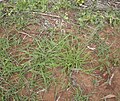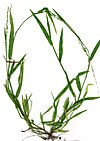Paniceae: Difference between revisions
Appearance
Content deleted Content added
Tylototriton (talk | contribs) →top: link "monoploid number" |
Tylototriton (talk | contribs) Disambiguated: Trachys → Trachys (plant), Spinifex → Spinifex (genus) |
||
| Line 56: | Line 56: | ||
*''[[Tarigidia]]'' |
*''[[Tarigidia]]'' |
||
*''[[Thyridachne]]'' |
*''[[Thyridachne]]'' |
||
*''[[Trachys]]'' |
*''[[Trachys (plant)|Trachys]]'' |
||
;Dichantheliinae |
;Dichantheliinae |
||
| Line 125: | Line 125: | ||
*''[[Setaria]]'' (syn. ''[[Paspalidium]]'') |
*''[[Setaria]]'' (syn. ''[[Paspalidium]]'') |
||
*''[[Setariopsis]]'' |
*''[[Setariopsis]]'' |
||
*''[[Spinifex]]'' |
*''[[Spinifex (genus)|Spinifex]]'' |
||
*''[[Stenotaphrum]]'' |
*''[[Stenotaphrum]]'' |
||
*''[[Stereochlaena]]'' |
*''[[Stereochlaena]]'' |
||
Revision as of 09:51, 30 December 2015
| Paniceae | |
|---|---|

| |
| Foxtail millet (Setaria italica) | |
| Scientific classification | |
| Kingdom: | |
| (unranked): | |
| (unranked): | |
| (unranked): | |
| Order: | |
| Family: | |
| Subfamily: | |
| Supertribe: | Panicodae L. Liu (1980)
|
| Tribe: | Paniceae R.Br. (1814)[1]
|
| Genera | |
|
84, see text | |
| Synonyms[2] | |
| |
Paniceae is a large tribe of the Panicoideae subfamily in the grasses (Poaceae), the only in the monotypic supertribe Panicodae. It includes roughly 1,500 species in 84 genera, primarily found in tropical and subtropical regions of the world.[2][3] Paniceae includes species using either of the C4 and C3 photosynthetic pathways, as well as presumably intermediate species.[2] Most of the millets are members of tribe Paniceae.
The tribe is subdivided into seven subtribes, but some genera are as yet unplaced (incertae sedis).[2] Species in the Paniceae have an ancestral chromosome number (monoploid number) of x = 9, while species with x = 10 formerly included are now recognised as separate tribe, Paspaleae.[4]
Subtribes and genera
- incertae sedis
- Chloachne
- Oryzidium
- Homopholis
- Hydrothauma
- Hylebates
- Poecilostachys
- Sacciolepis
- Thedachloa
- Trichanthecium
- Walwhalleya
- Anthephorinae
- Anthephora
- Chaetopoa
- Chlorocalymma
- Digitaria
- Megaloprotachne
- Taeniorhachis
- Tarigidia
- Thyridachne
- Trachys
- Dichantheliinae
- Boivinellinae
- Acroceras
- Alloteropsis
- Amphicarpum
- Cyphochlaena
- Cyrtococcum
- Echinochloa
- Entolasia
- Lasiacis
- Mayariochloa
- Morronea
- Microcalamus
- Oplismenus
- Ottochloa
- Parodiophyllochloa
- Pseudechinolaena
- Neurachninae
- Melinidinae
- Chaetium
- Eriochloa
- Eccoptocarpha
- Leucophrys
- Megathyrsus
- Melinis (syn. Rhynchelytrum)
- Mildbraediochloa
- Moorochloa
- Rupichloa
- Scutachne
- Thuarea
- Tricholaena
- Urochloa (syn. Brachiaria)
- Yvesia
- Panicinae
- Cenchrinae
- Acritochaete
- Alexfloydia
- Cenchrus (syn. Odontelytrum, Pennisetum, Snowdenia)
- Chamaeraphis
- Dissochondrus
- Holcolemma
- Hygrochloa
- Ixophorus
- Paractaenum
- Paratheria
- Plagiosetum
- Pseudochaetochloa
- Pseudoraphis
- Setaria (syn. Paspalidium)
- Setariopsis
- Spinifex
- Stenotaphrum
- Stereochlaena
- Streptolophus
- Uranthoecium
- Whiteochloa
- Xerochloa
- Zuloagaea
- Zygochloa
Gallery
References
- ^ Brown 1814, p. 582.
- ^ a b c d Soreng, Robert J.; Peterson, Paul M.; Romschenko, Konstantin; Davidse, Gerrit; Zuloaga, Fernando O.; Judziewicz, Emmet J.; Filgueiras, Tarciso S.; Davis, Jerrold I.; Morrone, Osvaldo (2015). "A worldwide phylogenetic classification of the Poaceae (Gramineae)". Journal of Systematics and Evolution. 53 (2): 117–137. doi:10.1111/jse.12150. ISSN 1674-4918.

- ^ Barkworth 2003, pp. 353–602.
- ^ Morrone, Osvaldo; Aagesen, Lone; Scataglini, Maria A.; Salariato, Diego L.; Denham, Silvia S.; Chemisquy, Maria A.; Sede, Silvana M.; Giussani, Liliana M.; Kellogg, Elizabeth A.; Zuloaga, Fernando O. (2012). "Phylogeny of the Paniceae (Poaceae: Panicoideae): integrating plastid DNA sequences and morphology into a new classification". Cladistics. 28 (4): 333–356. doi:10.1111/j.1096-0031.2011.00384.x. ISSN 0748-3007.
Sources
- Barkworth, M. (2003). "Paniceae" in Flora North America. Vol. 25. pp. 353–602.
- Brown, R. (1814). A Voyage to Terra Australis. Vol. 2. p. 582.
- "Paniceae". Tropicos.org. 2013.
- "USDA: GRIN Taxonomy for Plants". ars-grin.gov. 23 March 2006.
External links
Wikimedia Commons has media related to Paniceae.
Wikispecies has information related to Paniceae.
- Taxonomy browser (Paniceae) at ncbi.nlm.nih.gov.















